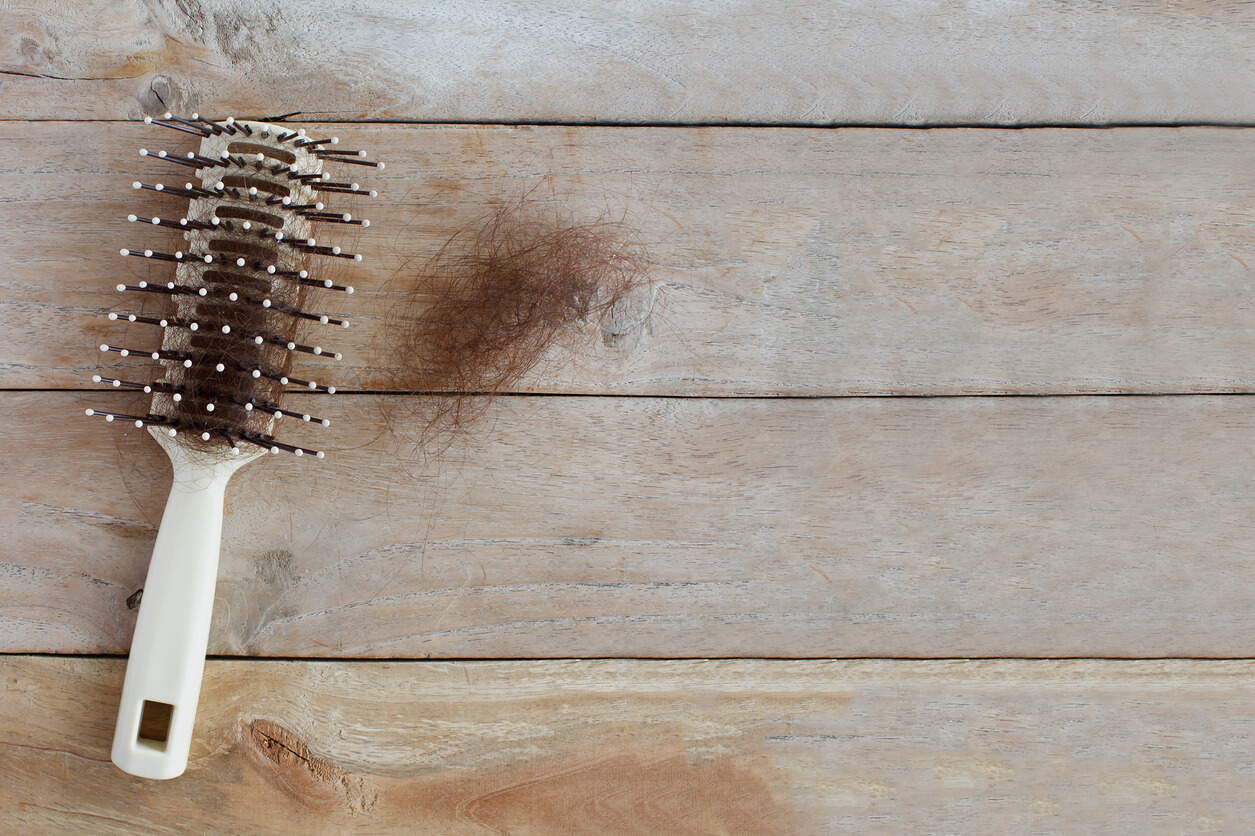How to Prevent Juvenile Alopecia

Hair loss used to be viewed as a problem exclusive to older people. However, today it’s increasingly experienced at younger ages and this is known as juvenile alopecia.
Although this condition can occur in people in good health, it’s important to pay attention when it happens repeatedly, as it could be a sign of an underlying hormonal disease.
In the article below, we’ll tell you everything you need to know about this condition.
What is juvenile alopecia?
As we’ve already mentioned, juvenile alopecia is the early loss of hair, especially on the head. This problem is more frequent in men than in women and occurs before the age of 30. However, most consultations for this condition are made around the age of 20.
The clinical manifestations of alopecia can vary in intensity, from very subtle (such as the famous “receding hairline”) to total hair loss in a few years.
In general, healthy people usually shed between 100 and 200 hairs per day. But in cases of juvenile alopecia, this amount increases dramatically.

Causes of juvenile alopecia
Juvenile alopecia can have multiple causes and you need to be aware of them to start the appropriate and effective treatment as soon as possible. Although genetic factors influence its appearance, there are others that are even more relevant and determining.
Among the most frequent causes, the following stand out:
- The use of very aggressive hair products
- Environmental pollution
- Excessive drying or ironing of hair
- Hair dyes
- Stress
- Bad eating habits
The cause of juvenile alopecia will determine whether the clinical picture is reversible or not. In men over 30 years of age and in some women, androgenetic alopecia is the main diagnosis. This disease variable is caused by a combination of hormonal imbalances and hereditary factors.
As a general guideline, it’s important to eliminate or at least restrict toxic habits (such as alcohol or tobacco use) in order to preserve skin and hair health.
Read also: What Is Juvenile Dermatomyositis?
Therapeutic options for juvenile alopecia
With any hair loss, the main thing is to arrive at the correct diagnosis and begin specific and appropriate treatment.
In fact, the best time to visit a dermatologist isn’t when the hair loss is noticeable, but when you notice that the hair has lost its healthy appearance. In other words, it has become weaker, thinner, or brittle.
You may be interested in: Hair Loss in Adolescence: Symptoms, Causes, and Treatment
How to prevent juvenile alopecia?
All treatments or procedures indicated for hair loss and regeneration attempt to modify the conditions for hair growth. Here are some of them.
Platelet-rich plasma (PRP)
This procedure of biological stimulation of the hair fiber helps to stop hair loss and stimulates stronger hair growth. It also helps to increase the hair shaft and improve the vascularization of the scalp.
The technique consists of obtaining a blood sample from the person, and after centrifugation, administering platelet stimulating factors. Finally, this fluid is injected into the scalp to achieve the effect.
One of the advantages of the treatment is that it doesn’t present adverse reactions or produce allergies, as it uses the body’s own platelets.
Hair mesotherapy
Preserved hair can be strengthened through procedures such as hair mesotherapy, which provide the necessary nutrients to the weakened follicle.
This type of procedure is also useful to improve recovery after diffuse or temporary alopecia.
Pharmacotherapy
There are quite effective drugs available to slow the progression of androgenic alopecia, which is quite common among young people. Two effective drugs are currently available: Finasteride and minoxidil.
Despite their usefulness, it’ll be up to the medical staff to decide on the indication of these drugs on the basis of a favorable risk-benefit balance for the individual.
Balanced and complete diet
A balanced diet, without excessive fats, sausages, or ultra-processed foods, is an important habit in the prevention of juvenile alopecia. The lack of nutrients can alter the healthy properties of the hair fiber.

Care and hygiene measures
You shouldn’t use products or cosmetic procedures that are aggressive to the hair, such as excessive heat, dyes, or tightly tied hairstyles.
It’s best to allow your hair to air dry or gently with a towel. However, if you want to use a hairdryer, do so at a certain distance to avoid thermal aggression.
Maintaining good hygiene is also essential, as excess sebum on the scalp acts negatively and damages the hair follicle. However, it’s preferable not to wash your hair every day.
Control environmental factors to prevent juvenile alopecia
In conclusion, although the genetic factor of juvenile alopecia isn’t a controllable aspect, you can try to maintain strong and healthy hair with some simple measures. Even when the first symptoms appear, they can slow down hair loss.
Therefore, avoid stress, eat a healthy diet, and lead a balanced life.
Hair loss used to be viewed as a problem exclusive to older people. However, today it’s increasingly experienced at younger ages and this is known as juvenile alopecia.
Although this condition can occur in people in good health, it’s important to pay attention when it happens repeatedly, as it could be a sign of an underlying hormonal disease.
In the article below, we’ll tell you everything you need to know about this condition.
What is juvenile alopecia?
As we’ve already mentioned, juvenile alopecia is the early loss of hair, especially on the head. This problem is more frequent in men than in women and occurs before the age of 30. However, most consultations for this condition are made around the age of 20.
The clinical manifestations of alopecia can vary in intensity, from very subtle (such as the famous “receding hairline”) to total hair loss in a few years.
In general, healthy people usually shed between 100 and 200 hairs per day. But in cases of juvenile alopecia, this amount increases dramatically.

Causes of juvenile alopecia
Juvenile alopecia can have multiple causes and you need to be aware of them to start the appropriate and effective treatment as soon as possible. Although genetic factors influence its appearance, there are others that are even more relevant and determining.
Among the most frequent causes, the following stand out:
- The use of very aggressive hair products
- Environmental pollution
- Excessive drying or ironing of hair
- Hair dyes
- Stress
- Bad eating habits
The cause of juvenile alopecia will determine whether the clinical picture is reversible or not. In men over 30 years of age and in some women, androgenetic alopecia is the main diagnosis. This disease variable is caused by a combination of hormonal imbalances and hereditary factors.
As a general guideline, it’s important to eliminate or at least restrict toxic habits (such as alcohol or tobacco use) in order to preserve skin and hair health.
Read also: What Is Juvenile Dermatomyositis?
Therapeutic options for juvenile alopecia
With any hair loss, the main thing is to arrive at the correct diagnosis and begin specific and appropriate treatment.
In fact, the best time to visit a dermatologist isn’t when the hair loss is noticeable, but when you notice that the hair has lost its healthy appearance. In other words, it has become weaker, thinner, or brittle.
You may be interested in: Hair Loss in Adolescence: Symptoms, Causes, and Treatment
How to prevent juvenile alopecia?
All treatments or procedures indicated for hair loss and regeneration attempt to modify the conditions for hair growth. Here are some of them.
Platelet-rich plasma (PRP)
This procedure of biological stimulation of the hair fiber helps to stop hair loss and stimulates stronger hair growth. It also helps to increase the hair shaft and improve the vascularization of the scalp.
The technique consists of obtaining a blood sample from the person, and after centrifugation, administering platelet stimulating factors. Finally, this fluid is injected into the scalp to achieve the effect.
One of the advantages of the treatment is that it doesn’t present adverse reactions or produce allergies, as it uses the body’s own platelets.
Hair mesotherapy
Preserved hair can be strengthened through procedures such as hair mesotherapy, which provide the necessary nutrients to the weakened follicle.
This type of procedure is also useful to improve recovery after diffuse or temporary alopecia.
Pharmacotherapy
There are quite effective drugs available to slow the progression of androgenic alopecia, which is quite common among young people. Two effective drugs are currently available: Finasteride and minoxidil.
Despite their usefulness, it’ll be up to the medical staff to decide on the indication of these drugs on the basis of a favorable risk-benefit balance for the individual.
Balanced and complete diet
A balanced diet, without excessive fats, sausages, or ultra-processed foods, is an important habit in the prevention of juvenile alopecia. The lack of nutrients can alter the healthy properties of the hair fiber.

Care and hygiene measures
You shouldn’t use products or cosmetic procedures that are aggressive to the hair, such as excessive heat, dyes, or tightly tied hairstyles.
It’s best to allow your hair to air dry or gently with a towel. However, if you want to use a hairdryer, do so at a certain distance to avoid thermal aggression.
Maintaining good hygiene is also essential, as excess sebum on the scalp acts negatively and damages the hair follicle. However, it’s preferable not to wash your hair every day.
Control environmental factors to prevent juvenile alopecia
In conclusion, although the genetic factor of juvenile alopecia isn’t a controllable aspect, you can try to maintain strong and healthy hair with some simple measures. Even when the first symptoms appear, they can slow down hair loss.
Therefore, avoid stress, eat a healthy diet, and lead a balanced life.
All cited sources were thoroughly reviewed by our team to ensure their quality, reliability, currency, and validity. The bibliography of this article was considered reliable and of academic or scientific accuracy.
- Al Aboud AM, Zito PM. Alopecia. [Updated 2021 Nov 15]. In: StatPearls [Internet]. Treasure Island (FL): StatPearls Publishing; 2022 Jan-. Available from: https://www.ncbi.nlm.nih.gov/books/NBK538178/
- Phillips TG, Slomiany WP, Allison R. Hair Loss: Common Causes and Treatment. Am Fam Physician. 2017 Sep 15;96(6):371-378. PMID: 28925637.
-
Gentile P, Garcovich S. Systematic Review of Platelet-Rich Plasma Use in Androgenetic Alopecia Compared with Minoxidil®, Finasteride®, and Adult Stem Cell-Based Therapy. Int J Mol Sci. 2020 Apr 13;21(8):2702. doi: 10.3390/ijms21082702. PMID: 32295047; PMCID: PMC7216252.
- Guo, Emily L, and Rajani Katta. “Diet and hair loss: effects of nutrient deficiency and supplement use”. Dermatology practical & conceptual vol. 7,1 1-10. 31 Jan. 2017, doi:10.5826/dpc.0701a01
This text is provided for informational purposes only and does not replace consultation with a professional. If in doubt, consult your specialist.








